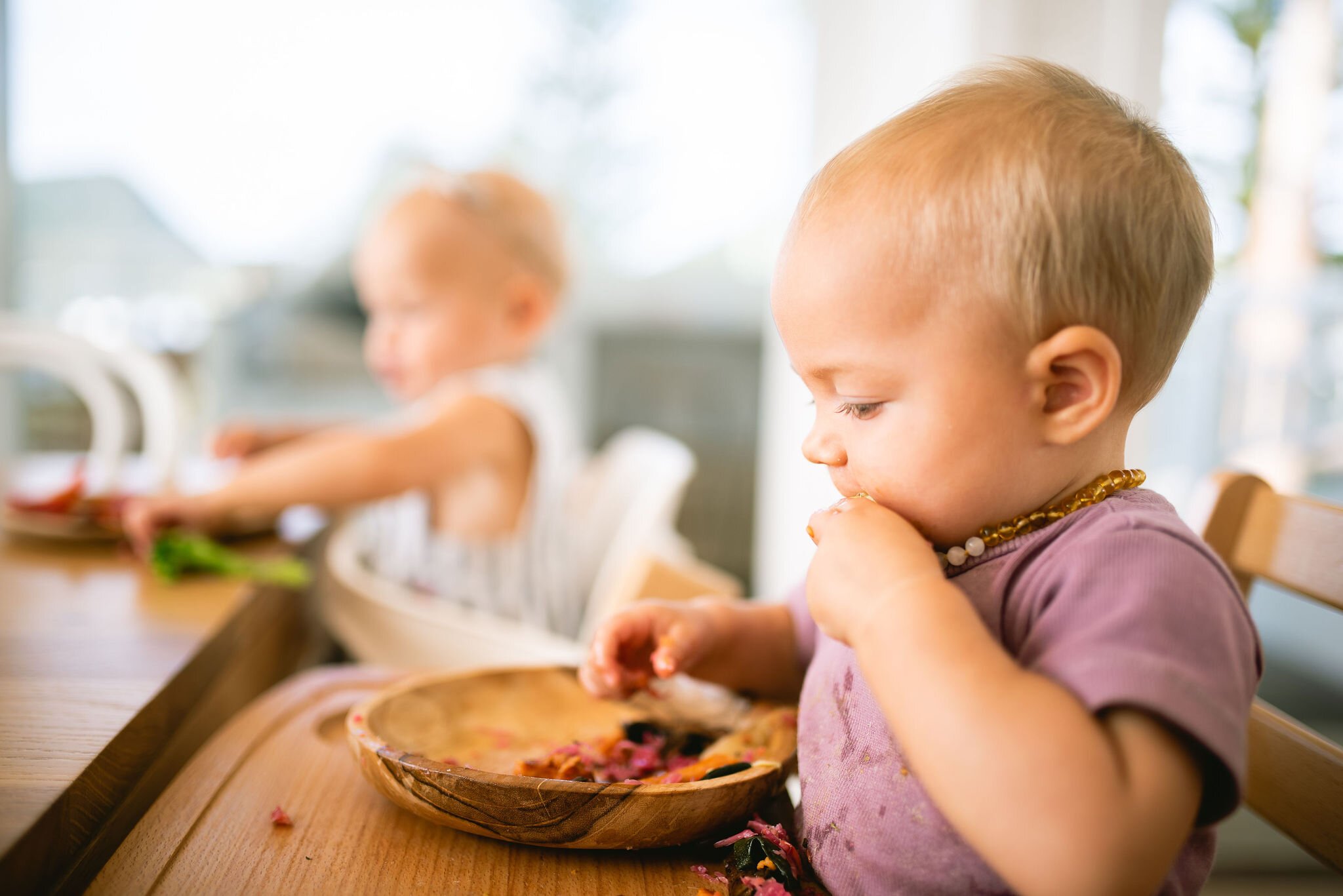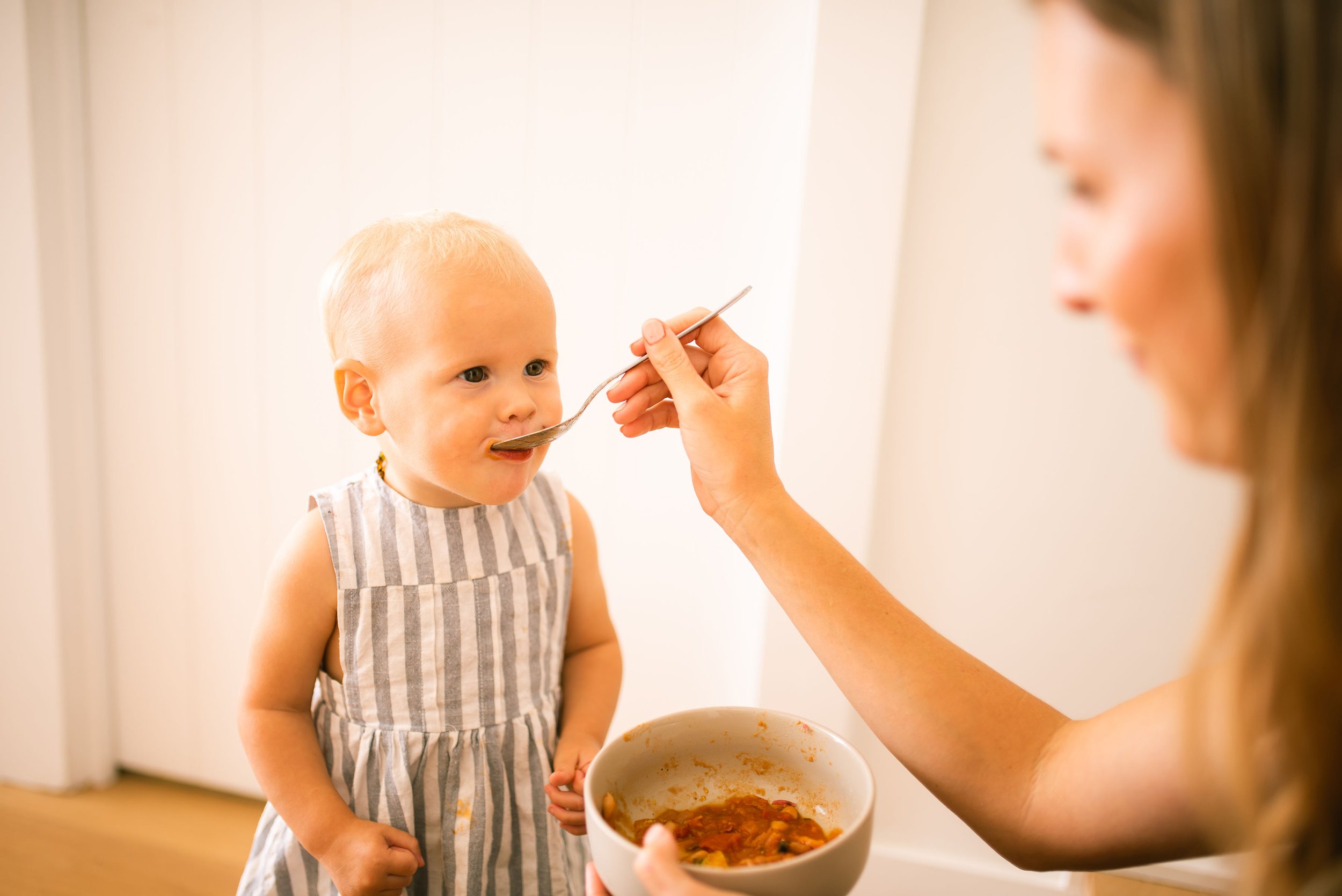I’m often asked how to get your toddler or other children to eat well and a variety of foods, and whilst we cannot in any way control what they eat, or how much they eat, there are some strategies we can adapt to help set up good eating foundations.
My first answer is always, always, always to practice and place importance on family mealtimes (keeping in mind we only need one adult present for a family meal!). For me, this was a given growing up and it’s something we are instilling into our own family. We play dinner music, we light a candle, we express gratitude for our meal and day and we spend the dinner talking to each other about our days and days to come. It’s a foundation and a habit that we have put emphasis on setting up from the get go! Whilst mealtimes can still be chaotic with our little ones, our older children now know what is expected of them and what they can expect from us as parents at mealtimes. If my husband is working late, or is out during dinner time, I still eat with the children because I know just how beneficial this routine is. (My husband already knows how to eat – he can eat alone later!).
There are so many reasons we advocate for placing value and emphasis on family meals. We know it lays foundations for healthy relationships with food and models to little ones how to eat and what to do with food and utensils, but it also cultivates a space for family bonding, communication, social skills, and table manners.
Research consistently demonstrates the benefits of family mealtimes:
-
Research shows that children who eat with their families are more likely to eat a wider range of fruits and vegetables during childhood and into adolescence (Larson et al., 2013). Kids see us eating and ENJOYING these foods and in turn will do the same. I love encouraging my kids to take their time to eat,looking at the different colours, experiencing different textures and smells. It’s a chance to talk to them about the flavours they are experiencing and the sensations that food brings.
-
Children who have regular family meals are more likely to eat a variety of foods, are healthier, are more likely to be able to self regulate their appetite and are associated with lower obesity rates (Fiese et a.l, 2012).
-
Children and teens who have family meals eat better, feel better about themselves, get along better with other people, and do better in school (Musick and Meier, 2012).
-
Research demonstrates lower levels of substance abuse, lower risk of depression, and lower risk of eating disorders in children and teens who eat with their family.
-
Family meals have more to do with raising healthy, happy children than family income, whether the child has one or two parents living in the home, after-school activities, tutors, or church!
SO HOW DO YOU ACHIEVE THIS WHEN LIFE IS SO BUSY?
1. Move mealtime earlier. For us it means that we have had to move mealtime to much earlier than we’d like to eat. We are now very used to it and actually find it much better for our digestion to eat early. Sometimes it means my husband doesn’t eat with us, so I will still eat with the kids, then join him at the table later again with my cup of tea…or not 😉
2. Schedule family meals for the week. Look at everyone’s schedules and decide which meals you’ll have together. It doesn’t always have to be dinner – breakfast or lunch works too. Aim for at least one adult at the dinner table if possible.
3. Collaborate. Ask your family about what they’d like to see on the menu! Children are more likely to be invested in the meals when they get to have some say in what will be served. If you have older children you could assign them a meal to cook for the family of their choice! For toddlers, you could get them involved (even though it’s painstakingly slow and messy) with food prep or give older toddlers the job of setting the table/serving the food.
4. Eat around the table, not in front of the television. It’s a time of gathering and relationship, a time to engage, to slow down and to be present.
TIPS FOR SUCCESSFUL MEALTIMES
1. Serve the same food for everyone in the family.
Making separate meals is not only time consuming, but also sets up unhealthy eating habits and expectations. We want to be considerate without catering by always offering at least one highly preferred food. This means we might adjust the food portions and presentation based on our child’s preferences and needs, but we try to avoid preparing separate meals (or back up meals!). Some examples…
-
If your little one would love their own meal of takeaway nuggets and chips, you might incorporate some home made nuggets in the family meal.
-
If you are making something you know your toddler won’t enjoy like a salad or stir fry all mixed together, you might serve the same foods deconstructed for your little one.
-
If you are having spaghetti bolognese and you know your toddler is struggling with meat textures, you might serve them a smaller portion of meat sauce and a large portion of spaghetti.
-
If you are eating a spicy chicken curry with rice, you might serve your child some unseasoned chicken and veggies with their rice.
-
And if the main dish isn’t usually popular, you might serve some sides that you know your child will enjoy and can fill up on. Include high-fat foods in their diet and meal (and yours!) for example avocado, coconut products, olive oil, fatty fish, butter/ghee, eggs, nuts and seeds etc.
I acknowledge that some meals won’t always be toddler appropriate, but as much as possible try to serve a derivative of what you are eating.
2. Follow the Division of Responsibility
The Division of Responsibility is an approach to feeding and mealtimes developed by Ellen Satter that recognises parents are responsible for deciding when a child eats, where they eat and what is offered, while recognising children are responsible for deciding whether and how much they eat. This approach encourages us as parents to offer a variety of foods and trust our child’s internal hunger and fullness cues (Satter, 2020). It’s not always easy! It means we need to ditch the pressure, bribery and “encouragement” techniques and trust our kids to listen to their bodies. Following this approach helps establish a healthy relationship with food and fosters self-regulation in eating. It is our job to provide the food, and it is their job to choose whether to eat (or not eat!) the food! Keep in mind that some children need up to 8-15 exposures before they choose to eat a new food (Carruth et al., 2004). All exposures are positive, even if your child doesn’t eat all the food offered.
3. Use big ‘self-serve’ options like bowls or platters to encourage independence.
Providing self-serve options allows children to take control of their own portions and encourages independence. (It’s also great for motor skills!) By using bowls or platters placed in the centre of the table, children can actively participate in choosing and serving themselves, fostering a sense of autonomy and promoting a positive relationship with food. Our family loves to build your own burrito or make your own sandwich.
4. Use snacks strategically to support mealtime.
We want children and grown-ups to arrive at the table hungry to eat. For this to happen, we can’t have access to food and drinks whenever we want! We like to recommend offering meals and snacks 2-3 hours apart, obviously with the exception of water. Depending on your child’s age you might communicate this with a visual schedule, by pointing to the clock or by using a countdown timer. If you find your little one isn’t hungry at dinner time you might want to bring afternoon tea earlier or think about how much food you are offering. Remember snacks can be just as nutritious as dinner! If your little one is more inclined to eat snacks rather than dinner, try offering their vegetables or ‘new’ foods at this time! When possible offer 2 or 3 foods that include protein, fat, and carbohydrates.
5. Don’t sit them down too early!
A top tip of mine, is don’t put your child in the highchair or at their chair at the table until ALL the food is ready and on the table. Once they get into that chair, the countdown timer is on, and word of warning – for young children it’s SHORT! My biggest recommendation is to let them move freely before dinnertime. They might move between play, running around or helping you prepare the food in a learning tower. We recommend finding a ‘cue’ that mealtime is about to begin. You might have a 5 minute warning/timer, a song to sing, or a hand washing routine – something that is their prompt that mealtime is soon to begin!
6. Get out of the dining room!
Pack up your food, bring a blanket and head out to the park, the garden, or the beach for a family picnic! Use this time to reconnect as a family. Sometimes we even sit around the living room on the floor on cushions (it’s become our custom for Indian food..I can’t remember how it started but it’s my son’s favourite thing!)
7. Talk about the foods you are eating.
Try to refrain from phrases such as ‘is it nice?’ or ‘do you like it?’, and instead, use phrases to discuss the foods you are eating such as ‘this pasta is so slimy isn’t it!’ or ‘do you think this tomato is sweet or sour?’ or ‘this carrot is so hard isn’t it’ etc! You can also talk about the benefits of the foods if you know them. For example ‘did you know carrots help your eyes see better?’ or ‘did you know fish helps our brains grow and get smarter!?’. However, try not to say these things in a way that could seem like you’re pressuring them to eat,just make it a general conversation. Talking about textures and colours and flavours of the foods helps your child to learn about food as a whole, and helps them to learn that different foods play a part in helping our bodies function and thrive!
IN SUMMARY
Family mealtimes take TIME and PRACTICE! Young children might only last a few minutes at the table before getting up and deciding they have had enough and want to get down. It takes time for them to learn appropriate mealtime behaviour and the only way they are going to learn this is by watching how YOU behave at mealtime, how you eat and converse and sit at the table. If they never see us doing this, how can we expect them to learn?
Does your family do family meal time? If not, give it a try for a couple of months and see if your toddler’s meal habits improve. One small step at a time, aiming for a couple of meals together a week, and I’d love to hear what difference it makes!
If you would like to read more information about when to seek help for fussy eating, head over to this blog!
We also have an amazing podcast episode with Rachael, our paediatric occupational therapist all about this topic if you’d like to have a listen to episode 11.
Luka x
Reviewed by Rachael Smith – Boob to Food Paediatric Occupational Therapist
REFERENCE LIST:
Carruth, B.R., Ziegler, P.J., Gordon, A. and Barr, S.I. (2004). Prevalence of picky eaters among infants and toddlers and their caregivers’ decisions about offering a new food. Journal of the American Dietetic Association, [online] 104, pp.57–64. doi:https://doi.org/10.1016/j.jada.2003.10.024.
Fiese, B. H., Hammons, A., & Grigsby-Toussaint, D. (2012). Family mealtimes: A contextual approach to understanding childhood obesity. Economics & Human Biology, 10(4), 365-374. doi: 10.1016/j.ehb.2012.04.005
Larson, N., MacLehose, R., Fulkerson, J. A., & Berge, J. M. (2013). Family meals during adolescence are associated with higher diet quality and healthful meal patterns during young adulthood. Journal of the American Dietetic Association, 113(12), 1601-1607. doi: 10.1016/j.jand.2013.07.032
Musick, K., & Meier, A. (2012). Assessing causality and persistence in associations between family dinners and adolescent well-being. Journal of Marriage and Family, 74(3), 476-493. doi: 10.1111/j.1741-3737.2012.00977.x
Satter, E. (2000). Child of Mine: Feeding with Love and Good Sense. Bull Publishing Company.








+ show comments
- Hide Comments
add a comment